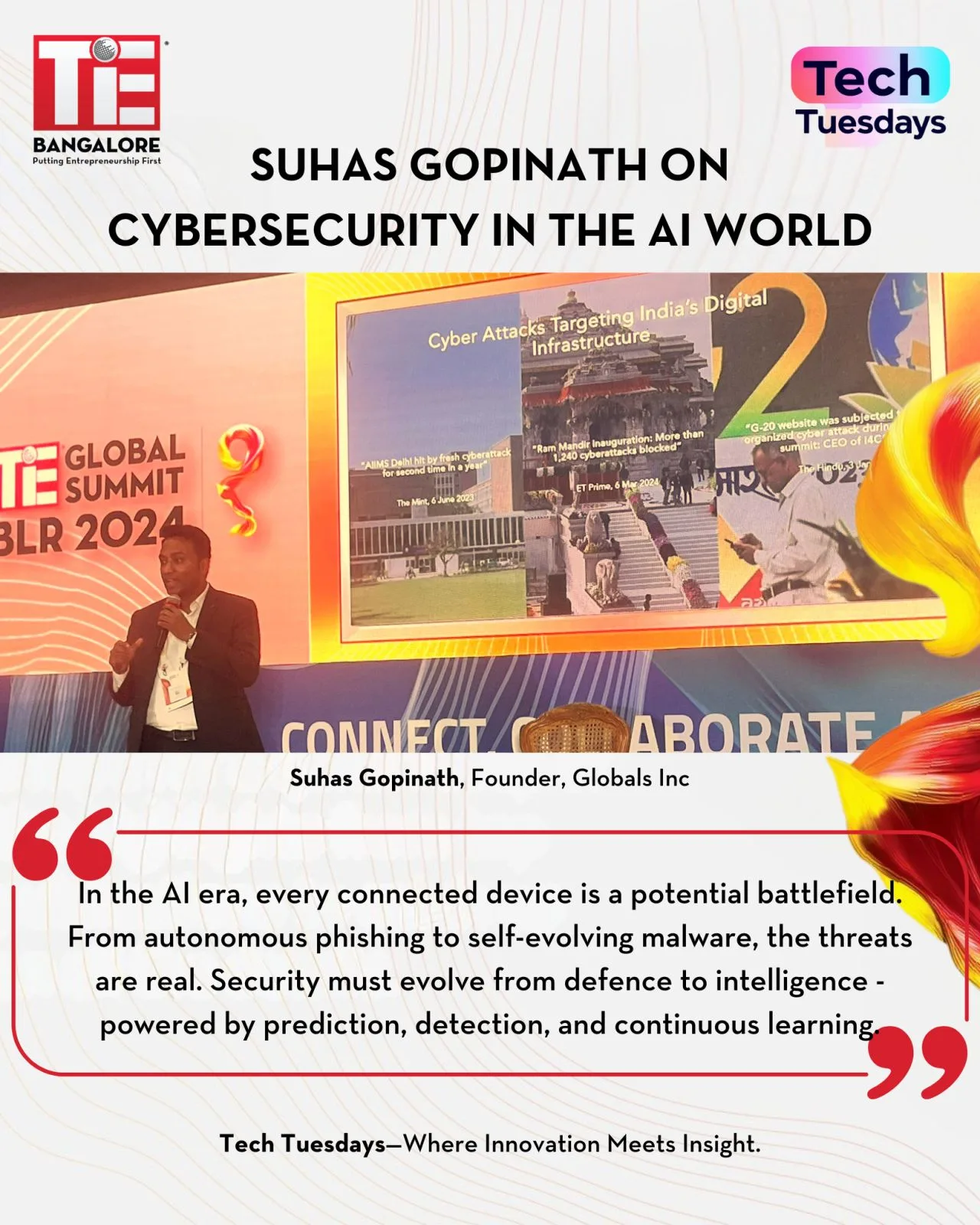The recent TIE Global Summit in Bangalore featured Suhas Gopinath, Founder of Globals Inc, who delivered a thought-provoking presentation on “Cybersecurity in the AI World.” His talk explored the multi-faceted relationship between AI and cybersecurity across three critical dimensions: AI-enabled cyberattacks, deploying AI for cyber defense, and securing AI systems themselves.
The Evolving Battlefield of Cybersecurity
“In the AI era, every connected device is a potential battlefield,” Gopinath emphasized during his presentation. “From autonomous phishing to self-evolving malware, the threats are real. Security must evolve from defence to intelligence – powered by prediction, detection, and continuous learning.”
This powerful statement encapsulates the paradigm shift happening in cybersecurity today. As artificial intelligence becomes more sophisticated, so do the tools and techniques employed by malicious actors.
AI-Enabled Cyberattacks: The Growing Threat
Gopinath detailed how artificial intelligence is transforming the nature of cyber threats. Modern attackers are leveraging AI to:
- Create sophisticated phishing campaigns that can mimic trusted entities with unprecedented accuracy
- Develop self-evolving malware that adapts to defensive measures in real-time
- Automate the discovery of zero-day vulnerabilities at scale
- Launch coordinated attacks that can overwhelm traditional defense systems
During his presentation, Gopinath shared concerning examples of AI-enhanced cyber attacks targeting India’s digital infrastructure. His slides showcased headlines about AIIMS Delhi experiencing fresh cyberattacks and Ram Mandir inauguration facing over 1240 cyberattacks blocked, demonstrating the real-world impact of these advanced threats.
Harnessing AI for Cyber Defense
The second dimension of Gopinath’s talk focused on how organizations can leverage AI as a powerful ally in strengthening cybersecurity postures. Drawing from Globals’ experience across sectors, he outlined several approaches:
- Predictive Analytics: Using machine learning algorithms to identify potential attack vectors before they’re exploited
- Anomaly Detection: Implementing AI systems that can recognize unusual patterns in network traffic or user behavior
- Automated Response: Deploying systems that can contain and mitigate threats without human intervention
- Continuous Learning: Creating security frameworks that improve over time by analyzing past incidents
Gopinath demonstrated how Globals has implemented these concepts across different industries:
- In banking and financial services, AI-powered email defense systems automatically prioritize and filter incoming messages to combat phishing
- For defense and aerospace, tactical Security Operations Centers employ real-time detection through hardware enforced cybersecurity and AI-enabled SOCs.
- In the satellite industry, AI-driven monitoring provides 24/7 protection against signal jamming and unauthorized access
Securing AI Systems Against Attacks
Perhaps most intriguing was Gopinath’s discussion of the third dimension: securing AI systems themselves from manipulation and compromise. As AI becomes increasingly integrated into critical infrastructure, protecting these systems becomes paramount. He outlined several vulnerabilities unique to AI systems:
- Data Poisoning: Where attackers manipulate training data to compromise AI performance
- Model Extraction: Techniques to steal proprietary AI models through careful probing
- Adversarial Examples: Specially crafted inputs designed to trick AI systems
- Backdoor Attacks: Hidden functionalities embedded in AI models that can be triggered by attackers
Through Globals’ R&D in it’s state-of-the-art facility in Bengaluru, Gopinath explained how hardware-enforced security measures like data diodes create physical barriers that can protect AI systems from certain classes of attacks, offering a crucial defense layer beyond software solutions.
A New Security Paradigm
What distinguishes Gopinath’s approach is the emphasis on holistic security that addresses the complex interplay between AI as threat, defender, and protected asset. The cybersecurity solutions developed by Globals incorporate:
- AI-powered threat detection and response
- Real-time monitoring through specialized Security Operations Centers
- Supply chain attack prevention
- Hardware-enforced security boundaries
- Rapid response capabilities for incident management
Looking Forward
As Gopinath concluded his presentation, he emphasized that organizations must prepare for a future where AI plays an increasingly central role in both cyber attacks and defense. The integration of artificial intelligence into security protocols offers unprecedented capabilities for prediction and prevention, but also requires a fundamental shift in how organizations conceptualize their security architecture.
The standing-room-only audience at the TIE Global Summit demonstrated the growing recognition among business leaders that managing the complex relationship between AI and cybersecurity is not merely a technical concern but a fundamental business imperative.
“Security must evolve from defence to intelligence,” Gopinath reminded attendees. In today’s rapidly advancing technological landscape, this evolution isn’t optional—it’s essential for survival in the digital age.
This blog post recaps Suhas Gopinath’s presentation during the TIE Global Summit BLR 2024 held on 11th December 2024 at Bengaluru International Exhibition Center

